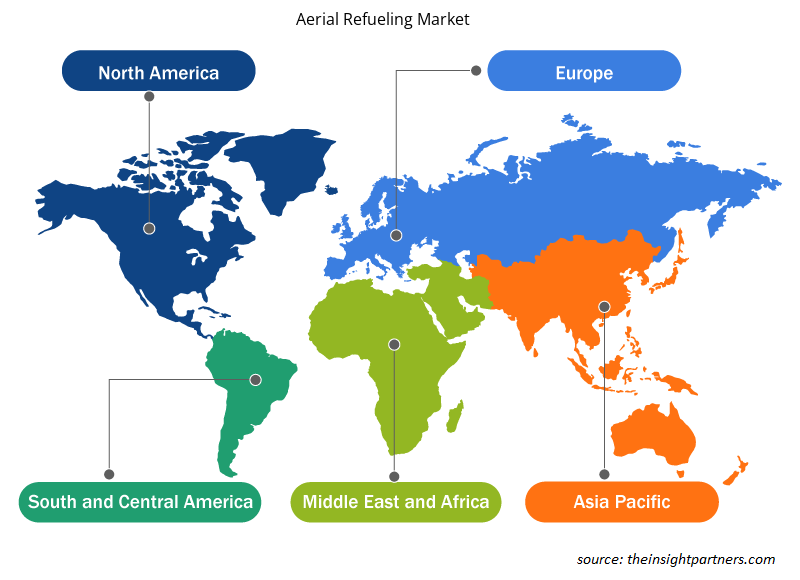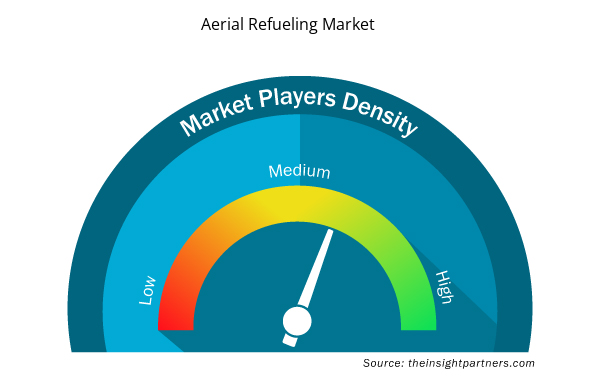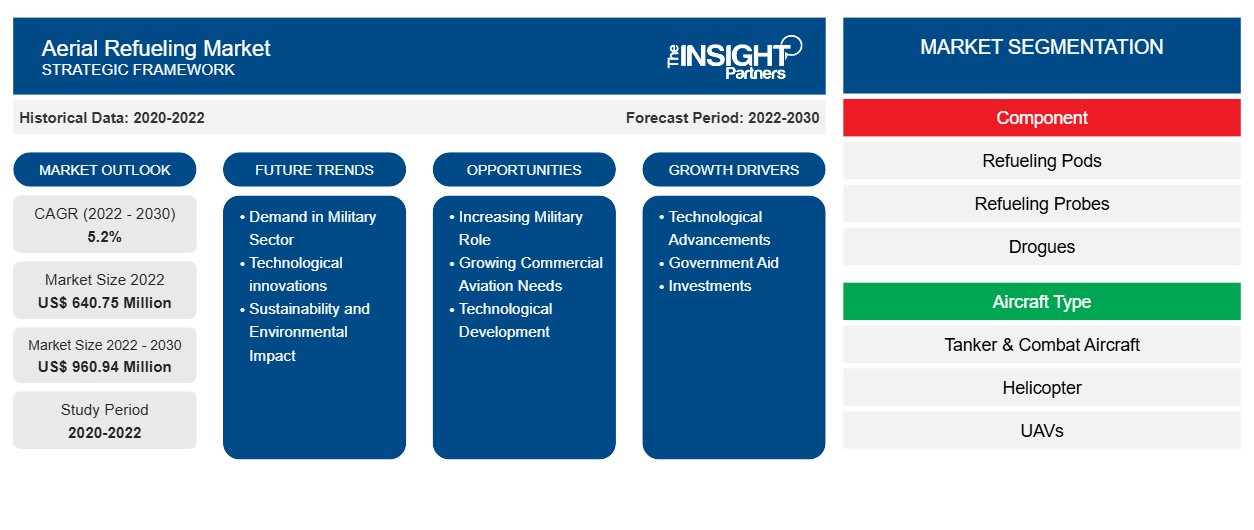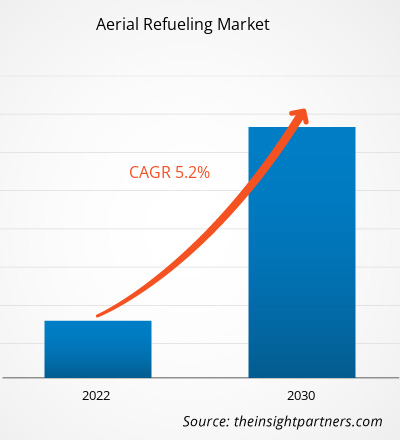[Informe de investigación] El mercado de reabastecimiento aéreo se valoró en US$ 640,75 millones en 2022 y se espera que alcance los US$ 960,94 millones en 2030; se anticipa que registre una CAGR del 5,2% entre 2022 y 2030.CAGR of 5.2% from 2022 to 2030.
Perspectiva del analista:
El pronóstico del mercado de reabastecimiento aéreo se estima sobre la base de varios hallazgos de investigación primaria y secundaria, como publicaciones de empresas clave, datos de asociaciones y bases de datos. El mercado de reabastecimiento aéreo ha experimentado un tremendo crecimiento en los últimos años. Uno de los principales factores que impulsan el mercado es el aumento de la flota mundial de aviones militares y el reemplazo o reacondicionamiento de las flotas de aviones cisterna militares más antiguas. Otro factor importante que impulsa el mercado incluye el creciente desarrollo de aviones cisterna de reabastecimiento no tripulados que actualmente se están probando para sus primeras operaciones reales entre diferentes fuerzas armadas. Los fabricantes que operan en el mercado se están centrando principalmente en el desarrollo de productos innovadores para seguir siendo competitivos. Sin embargo, algunos de los factores que obstaculizan el crecimiento del mercado de reabastecimiento aéreo incluyen el aumento de las preocupaciones ambientales causadas por las operaciones de las aeronaves y los mayores costos de instalación de los componentes del sistema de reabastecimiento. El informe incluye perspectivas de crecimiento a la luz de las tendencias actuales del mercado de reabastecimiento aéreo y los factores impulsores que influyen en el crecimiento del mercado.
Descripción general del mercado:
El mercado de reabastecimiento aéreo está moderadamente consolidado, con la presencia de un número limitado de actores que operan en diferentes regiones. Además, algunos países han estado impulsando sus inversiones militares en términos de adquisición de modelos de aviones cisterna más nuevos para reemplazar su flota de aviones cisterna más antigua, que está obsoleta y requiere enormes fuentes monetarias para operar con éxito. Además, las tensiones constantes entre países como Rusia-Ucrania, China-Taiwán, Israel-Palestina, EE. UU.-China, India-Pakistán e India-China también están impulsando la concienciación sobre la adquisición de nuevos modelos de aviones militares y aviones cisterna para fortalecer sus respectivas fuerzas armadas. Además, estas tensiones también se deben a la creciente competencia geopolítica entre diferentes países para fortalecer sus respectivas fuerzas armadas. Por lo tanto, están adquiriendo tecnologías avanzadas y agregando valor a sus respectivas fuerzas armadas. Estos factores están apoyando el despliegue de aviones cisterna y aviones de combate, lo que genera aún más la necesidad de sistemas de reabastecimiento aéreo en diferentes regiones.
Personalice este informe según sus necesidades
Obtendrá personalización en cualquier informe, sin cargo, incluidas partes de este informe o análisis a nivel de país, paquete de datos de Excel, así como también grandes ofertas y descuentos para empresas emergentes y universidades.
- Obtenga las principales tendencias clave del mercado de este informe.Esta muestra GRATUITA incluirá análisis de datos, desde tendencias del mercado hasta estimaciones y pronósticos.
Conductor del mercado:
La creciente adquisición de aeronaves y helicópteros militares genera demanda de sistemas de reabastecimiento aéreo
La creciente demanda de tecnologías avanzadas para neutralizar los ataques con misiles, junto con la mejora del proceso de identificación o localización del área objetivo y la vigilancia y detección de posibles amenazas aéreas, está impulsando la aplicación de reabastecimiento aéreo avanzado en aviones militares, jets y helicópteros. Los organismos gubernamentales de diferentes países están invirtiendo sustancialmente en la adquisición de aviones militares, jets de combate y helicópteros de alta gama para hacer frente a las crecientes amenazas aéreas, lo que también está ampliando el alcance de aplicación del reabastecimiento aéreo y de los aviones cisterna de reabastecimiento a nivel mundial. Hay un número creciente de contratos y acuerdos para adquirir aviones y helicópteros de defensa avanzados para combatir el aumento de los ataques aéreos avanzados. A continuación se mencionan algunas de las principales inversiones, contratos y acuerdos:
- En 2023, la empresa Boeing se adjudicó un contrato por valor de 12.000 millones de dólares para el suministro de helicópteros de ataque Apache a Polonia. Se espera que Polonia reciba 96 unidades de helicópteros de ataque Apache AH-64E.
- En 2022, el gobierno de EE. UU. y Lockheed Martin finalizaron el contrato para la producción y entrega de 398 F-35 por unos 30 mil millones de dólares.
- En 2022, la Fuerza Aérea India anunció su plan de adquirir 114 aviones de combate, de los cuales se espera que 96 se desarrollen en el país.
- En 2022, Suiza firmó un acuerdo para adquirir tres docenas de aviones de combate F-35A.
- En 2022, L3Harris Technologies Inc. consiguió un contrato por valor de 3.000 millones de dólares para suministrar aviones militares al Comando de Operaciones Especiales de Estados Unidos.
Así, la creciente adquisición de aviones y helicópteros militares para combatir los crecientes casos de ataques aéreos impulsa el mercado de reabastecimiento aéreo.
Análisis segmental:
Según los componentes, el mercado se segmenta en cápsulas de reabastecimiento, sondas de reabastecimiento, drogues, mangueras, plumas y otros. En 2022, el segmento de las plumas dominó la cuota de mercado del reabastecimiento aéreo, y también se espera que mantenga su dominio durante el período de pronóstico. Además, las mangueras y las cápsulas de reabastecimiento son dos de los principales segmentos que se prevé que registren las CAGR saludables en el mercado del reabastecimiento aéreo de 2022 a 2030. Los principales factores que impulsan el crecimiento del segmento de las plumas son su mayor precio, la integración de la tecnología y el hecho de que permite al operador realizar operaciones de reabastecimiento sin problemas durante cualquier vuelo aéreo. Sin embargo, es probable que el segmento de las plumas registre un crecimiento lento durante el período de pronóstico debido a la mayor demanda de sistemas de sonda y drogue en el escenario actual en diferentes regiones. La demanda de sistemas de sonda y drogue está aumentando debido a sus precios razonables, flexibilidad, facilidad de instalación y otros parámetros. Es probable que estos factores impulsen el tamaño del mercado del reabastecimiento aéreo durante el período de pronóstico.
Análisis regional:
En términos de ingresos, América del Norte dominó la participación de mercado de reabastecimiento aéreo en 2022, y también se espera que mantenga su dominio durante el período de pronóstico. El mercado de reabastecimiento aéreo de América del Norte se valoró en US$ 275,01 millones en 2022 y se proyecta que alcance los US$ 413,21 millones para 2030; se espera que registre una CAGR del 5,2% entre 2022 y 2030. América del Norte alberga algunos de los principales fabricantes de equipos originales de aeronaves, como Boeing, Bombardier, Lockheed Martin y Airbus, que tienen sus respectivas instalaciones de producción en diferentes partes de la región y siguen generando nueva demanda de sistemas de reabastecimiento aéreo desde sus respectivas instalaciones. Estos factores han estado impulsando la demanda de productos de reabastecimiento aéreo en toda la región. Además, otro factor importante que cataliza el crecimiento del mercado de reabastecimiento aéreo de América del Norte incluye la presencia de fabricantes de sistemas de reabastecimiento aéreo en países como Estados Unidos y Canadá. Entre estas empresas se incluyen proveedores como Eaton, GE Aviation, Marshall Aerospace & Defense Group, Parker Hannifin Corporation, Boeing y Raytheon Technologies Corporation.
Perspectivas regionales del mercado de reabastecimiento aéreo
Los analistas de Insight Partners explicaron en detalle las tendencias y los factores regionales que influyen en el mercado de reabastecimiento aéreo durante el período de pronóstico. Esta sección también analiza los segmentos y la geografía del mercado de reabastecimiento aéreo en América del Norte, Europa, Asia Pacífico, Oriente Medio y África, y América del Sur y Central.

- Obtenga datos regionales específicos para el mercado de reabastecimiento aéreo
Alcance del informe sobre el mercado de reabastecimiento de combustible en vuelo
| Atributo del informe | Detalles |
|---|---|
| Tamaño del mercado en 2022 | US$ 640,75 millones |
| Tamaño del mercado en 2030 | US$ 960,94 millones |
| CAGR global (2022-2030) | 5,2% |
| Datos históricos | 2020-2022 |
| Período de pronóstico | 2022-2030 |
| Segmentos cubiertos | Por componente
|
| Regiones y países cubiertos | América del norte
|
| Líderes del mercado y perfiles de empresas clave |
|
Densidad de actores del mercado: comprensión de su impacto en la dinámica empresarial
El mercado de reabastecimiento aéreo está creciendo rápidamente, impulsado por la creciente demanda de los usuarios finales debido a factores como la evolución de las preferencias de los consumidores, los avances tecnológicos y una mayor conciencia de los beneficios del producto. A medida que aumenta la demanda, las empresas amplían sus ofertas, innovan para satisfacer las necesidades de los consumidores y aprovechan las tendencias emergentes, lo que impulsa aún más el crecimiento del mercado.
La densidad de actores del mercado se refiere a la distribución de las empresas o firmas que operan dentro de un mercado o industria en particular. Indica cuántos competidores (actores del mercado) están presentes en un espacio de mercado determinado en relación con su tamaño o valor total de mercado.
Las principales empresas que operan en el mercado de reabastecimiento aéreo son:
- Cobham Sociedad Anónima
- Azafran
- Comer
- GE Aviación
- Grupo Aeroespacial y de Defensa Marshall
Descargo de responsabilidad : Las empresas enumeradas anteriormente no están clasificadas en ningún orden particular.

- Obtenga una descripción general de los principales actores clave del mercado de reabastecimiento aéreo
Análisis de los jugadores clave:
El análisis del mercado de reabastecimiento aéreo se lleva a cabo mediante la identificación y evaluación de los actores clave del mercado en diferentes regiones. L3Harris Technologies Inc, Raytheon Technologies Corporation, Curtiss-Wright Corporation, Honeywell International Inc, General Electric Company, Safran SA, BAE Systems Plc, Moog Inc, Meggitt Plc y Garmin Ltd se encuentran entre los actores destacados que se describen en el informe de mercado de reabastecimiento aéreo. Además, Cobham Plc, Safran, Eaton, GE Aviation y Marshall Aerospace & Defense Group se consideran entre los principales actores del mercado debido a la cartera de productos diversificada que ofrecen.
Desarrollos recientes:
El informe del mercado de reabastecimiento aéreo incluye el posicionamiento y la concentración de la empresa para evaluar el desempeño de los competidores/jugadores en el mercado. Las estrategias inorgánicas y orgánicas, como lanzamientos de productos, fusiones y adquisiciones, son ampliamente adoptadas por las empresas en el mercado de reabastecimiento aéreo. A continuación se mencionan algunos de estos casos:
- En febrero de 2021, Eaton compró la unidad de sistemas de reabastecimiento aéreo de Cobham Plc en EE. UU. en un acuerdo por valor de 2.800 millones de dólares.
- En noviembre de 2023, Eaton anunció que había realizado con éxito las pruebas de su prototipo de drogue estabilizado activamente de nuevo diseño, centrado principalmente en el reabastecimiento aéreo autónomo para aviones de combate de próxima generación.
Así, estos factores han estado catalizando el crecimiento del mercado de reabastecimiento aéreo desde la perspectiva de los proveedores.
- Análisis histórico (2 años), año base, pronóstico (7 años) con CAGR
- Análisis PEST y FODA
- Tamaño del mercado Valor/volumen: global, regional, nacional
- Industria y panorama competitivo
- Conjunto de datos de Excel


- Clear Aligners Market
- Lyophilization Services for Biopharmaceuticals Market
- Molecular Diagnostics Market
- Batter and Breader Premixes Market
- Saudi Arabia Drywall Panels Market
- Biopharmaceutical Tubing Market
- Hot Melt Adhesives Market
- Grant Management Software Market
- Latent TB Detection Market
- Authentication and Brand Protection Market

Report Coverage
Revenue forecast, Company Analysis, Industry landscape, Growth factors, and Trends

Segment Covered
This text is related
to segments covered.

Regional Scope
North America, Europe, Asia Pacific, Middle East & Africa, South & Central America

Country Scope
This text is related
to country scope.
Preguntas frecuentes
Cobham Plc, Safran, Eaton, GE Aviation, and Marshall Aerospace & Defense Group are some of the key market players operating in the global aerial refueling market.
Deployment of refueling tanker UAVs into military forces is one of the major trends expected to drive the market in the coming years.
North America is expected to account for the largest share during the forecast period and it is likely to retain its dominance during the forecast period as well.
Increasing awareness for strengthening armed forces of different countries and rising military aircraft fleet are some of the key factors likely to generate new opportunities for market vendors during the forecast period.
Surge in global military expenditure and rising procurement of refueling tanker aircraft are contributing to the growth of aerial refueling market.
Trends and growth analysis reports related to Aerospace and Defense : READ MORE..
The List of Companies - Aerial Refueling Market
- Cobham Plc
- Safran
- Eaton
- GE Aviation
- Marshall Aerospace & Defense Group
- Parker Hannifin Corporation
- Israel Aerospace Industries Ltd
- BAE Systems Plc
- Elbit Systems Ltd
- ARESIA
The Insight Partners performs research in 4 major stages: Data Collection & Secondary Research, Primary Research, Data Analysis and Data Triangulation & Final Review.
- Data Collection and Secondary Research:
As a market research and consulting firm operating from a decade, we have published and advised several client across the globe. First step for any study will start with an assessment of currently available data and insights from existing reports. Further, historical and current market information is collected from Investor Presentations, Annual Reports, SEC Filings, etc., and other information related to company’s performance and market positioning are gathered from Paid Databases (Factiva, Hoovers, and Reuters) and various other publications available in public domain.
Several associations trade associates, technical forums, institutes, societies and organization are accessed to gain technical as well as market related insights through their publications such as research papers, blogs and press releases related to the studies are referred to get cues about the market. Further, white papers, journals, magazines, and other news articles published in last 3 years are scrutinized and analyzed to understand the current market trends.
- Primary Research:
The primarily interview analysis comprise of data obtained from industry participants interview and answers to survey questions gathered by in-house primary team.
For primary research, interviews are conducted with industry experts/CEOs/Marketing Managers/VPs/Subject Matter Experts from both demand and supply side to get a 360-degree view of the market. The primary team conducts several interviews based on the complexity of the markets to understand the various market trends and dynamics which makes research more credible and precise.
A typical research interview fulfils the following functions:
- Provides first-hand information on the market size, market trends, growth trends, competitive landscape, and outlook
- Validates and strengthens in-house secondary research findings
- Develops the analysis team’s expertise and market understanding
Primary research involves email interactions and telephone interviews for each market, category, segment, and sub-segment across geographies. The participants who typically take part in such a process include, but are not limited to:
- Industry participants: VPs, business development managers, market intelligence managers and national sales managers
- Outside experts: Valuation experts, research analysts and key opinion leaders specializing in the electronics and semiconductor industry.
Below is the breakup of our primary respondents by company, designation, and region:

Once we receive the confirmation from primary research sources or primary respondents, we finalize the base year market estimation and forecast the data as per the macroeconomic and microeconomic factors assessed during data collection.
- Data Analysis:
Once data is validated through both secondary as well as primary respondents, we finalize the market estimations by hypothesis formulation and factor analysis at regional and country level.
- Macro-Economic Factor Analysis:
We analyse macroeconomic indicators such the gross domestic product (GDP), increase in the demand for goods and services across industries, technological advancement, regional economic growth, governmental policies, the influence of COVID-19, PEST analysis, and other aspects. This analysis aids in setting benchmarks for various nations/regions and approximating market splits. Additionally, the general trend of the aforementioned components aid in determining the market's development possibilities.
- Country Level Data:
Various factors that are especially aligned to the country are taken into account to determine the market size for a certain area and country, including the presence of vendors, such as headquarters and offices, the country's GDP, demand patterns, and industry growth. To comprehend the market dynamics for the nation, a number of growth variables, inhibitors, application areas, and current market trends are researched. The aforementioned elements aid in determining the country's overall market's growth potential.
- Company Profile:
The “Table of Contents” is formulated by listing and analyzing more than 25 - 30 companies operating in the market ecosystem across geographies. However, we profile only 10 companies as a standard practice in our syndicate reports. These 10 companies comprise leading, emerging, and regional players. Nonetheless, our analysis is not restricted to the 10 listed companies, we also analyze other companies present in the market to develop a holistic view and understand the prevailing trends. The “Company Profiles” section in the report covers key facts, business description, products & services, financial information, SWOT analysis, and key developments. The financial information presented is extracted from the annual reports and official documents of the publicly listed companies. Upon collecting the information for the sections of respective companies, we verify them via various primary sources and then compile the data in respective company profiles. The company level information helps us in deriving the base number as well as in forecasting the market size.
- Developing Base Number:
Aggregation of sales statistics (2020-2022) and macro-economic factor, and other secondary and primary research insights are utilized to arrive at base number and related market shares for 2022. The data gaps are identified in this step and relevant market data is analyzed, collected from paid primary interviews or databases. On finalizing the base year market size, forecasts are developed on the basis of macro-economic, industry and market growth factors and company level analysis.
- Data Triangulation and Final Review:
The market findings and base year market size calculations are validated from supply as well as demand side. Demand side validations are based on macro-economic factor analysis and benchmarks for respective regions and countries. In case of supply side validations, revenues of major companies are estimated (in case not available) based on industry benchmark, approximate number of employees, product portfolio, and primary interviews revenues are gathered. Further revenue from target product/service segment is assessed to avoid overshooting of market statistics. In case of heavy deviations between supply and demand side values, all thes steps are repeated to achieve synchronization.
We follow an iterative model, wherein we share our research findings with Subject Matter Experts (SME’s) and Key Opinion Leaders (KOLs) until consensus view of the market is not formulated – this model negates any drastic deviation in the opinions of experts. Only validated and universally acceptable research findings are quoted in our reports.
We have important check points that we use to validate our research findings – which we call – data triangulation, where we validate the information, we generate from secondary sources with primary interviews and then we re-validate with our internal data bases and Subject matter experts. This comprehensive model enables us to deliver high quality, reliable data in shortest possible time.


 Obtenga una muestra gratuita de este informe
Obtenga una muestra gratuita de este informe